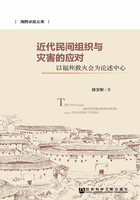
Abstract
Through the exploration of documents, local literatures and modern newspapers, oral historical material and fieldwork research, this paper aims to analyze how the people in Fuzhou make self-adjustment to cope with natural disaster under social transition and social turbulence since the Ming and the Qing Dynasty from the angle of natural environment of Fuzhou, market network, folk religion, and local power, so as to explain the relationship among natural disasters, folk organizations transformation, and grass-roots autonomy.
Before opening the port, disasters happened frequently in Fuzhou while cultural activities were prosperous. For one thing, the nongovernmental organization which offers sacrifice to god of Plague Wudi prevailed and became the primary organization of grass-root community below county-level in Fuzhou;for the other thing, a large number of gentry presided over the public affairs, such as disaster relief, dredging lake and building bridge, they even control government affairs, leaving the city in an autonomous state. After opening the port, social and economic structure of Fuzhou changed greatly, with the prosperity of commerce and business, the popular use of kerosene. Meanwhile, fire occurred frequently in Fuzhou, so the city was known as“the paper city”. With the diversification of social power, the infiltration of foreigner influence, the rising of merchant class, the dominance of genty was shocked, but they still had considerable influence. Fuzhou local government also adjusted its community management system, implemented United-household(Lianjia)residence registration system, and established Household Management(Baojia)Bureau, but achieved limited effectiveness. Consequently, social problems prevailed and fire accidents were out of control.
A series of institutional changes, including the abolishment of imperial examinations and the implementation of local autonomy in the late of Qing Dynasty, had a great influence on Fuzhou local society, putting an end to the official-gentry united governance model. Since then, Fuzhou fire brigade began rising. On one hand, its ups and downs had close relationship with national force. In the early of the Republic of China, the situation of Fuzhou remained turbulent and the political power changed frequently. The fire brigade developed rabidly in the area where government power was absent and reached its zenith in the late 1920s. Due to the strengthen of government control, its power had been shrinking. Since the founding of People's Republic of China, various local associations had almost vanished, but the fire brigade was still active until the completion of three major transformation of agriculture, handicraft industry and capitalism industry and commerce in the 1950s. It gained its rejuvenation in the 1980s and still has its influence nowadays with a history of more than 100 years. On the other hand, the fire brigade was transformed from the nongovernmental“She”and“jing”organization named“she”and“jing”. There were 37 fire brigades in Fuzhou during the period of Republic of China whose spatial distribution was similar to that of the“She”and“jin”organization. presenting its new in the new historical era. They were located in“jin”temple. Drawing support from folk belief, fire brigade integrated all classes of people and gained widespread recognition regardless of people's difference in birth origin and occupation. That is the key to its long term existence.
Besides the analysis of the history of the development of local society, this paper reviews the temporal and spatial distribution of fire brigade all over China before the founding of the PRC and presented them with chart and analyze the data. Fire brigade had its origin during the late Ming and early Qing periods. There were lots of fire brigade in Jiangnan and Zhili Province and were extended to inland area and coastal wings with the expansion of market network during the reigns of Tongzhi and Guangxu(1862-1908). It became very popular during the Republic of China and disappeared rapidly after the Founding of PRC. Compared with Beijing and Shanghai, although fire brigade in Fuzhou started late, it had so many functions and lasted for such a long time that is very rare all over the country. That is related to the frequence, conflagration, firefear local character and the special structure of local power.
This paper argues that fire is a threat to the safety of city and fire brigade not only reflects the reconstruction of social relationships in city, but also represents the decline and growth of forces between government and citizens. Both of the forces stay in a dynamic balance through support and conflict between them. Most of the fire brigade were transformed from traditional organization as a result of self-adjustment of social organizations. Taking the fire brigade as a point of penetration to see greatness from triviality, the study discusses the operation mechanism of Fuzhou city since the Ming and Qing dynasties from micro and macro perspectives so as to enhance the understanding of disaster and social problems and provide reference for today's social management.
Keywords: natural disasters; Fuzhou fire brigade; nongovernmental organization; modern times